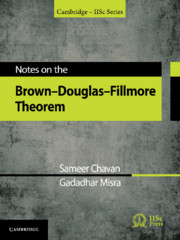Book contents
- Frontmatter
- Dedication
- Contents
- Preface
- From: The Evolution of Modern Analysis, R. G. Douglas
- Overview
- 1 Spectral Theory for Hilbert Space Operators
- 2 Ext(X) as a Semigroup with Identity
- 3 Splitting and the Mayer–Vietoris Sequence
- 4 Determination of Ext(X) as a Group for Planar Sets
- 5 Applications to Operator Theory
- Epilogue
- Appendix A Point Set Topology
- Appendix B Linear Analysis
- Appendix C The Spectral Theorem
- References
- Subject Index
- Index of Symbols
Appendix C - The Spectral Theorem
Published online by Cambridge University Press: 30 June 2021
- Frontmatter
- Dedication
- Contents
- Preface
- From: The Evolution of Modern Analysis, R. G. Douglas
- Overview
- 1 Spectral Theory for Hilbert Space Operators
- 2 Ext(X) as a Semigroup with Identity
- 3 Splitting and the Mayer–Vietoris Sequence
- 4 Determination of Ext(X) as a Group for Planar Sets
- 5 Applications to Operator Theory
- Epilogue
- Appendix A Point Set Topology
- Appendix B Linear Analysis
- Appendix C The Spectral Theorem
- References
- Subject Index
- Index of Symbols
Summary
This appendix is devoted to the various forms of spectral theorems for normal operators used in this book. We also present several applications of the spectral theorem.
Spectral Theorem
Let Σ be a σ-algebra over a set Ω. A spectral measure is an orthogonal projection-valued mapping with E(Ω) = I such that
(1) and for every
(2) is a complex measure for every.
Example C.1.1 (Multiplication by Characteristic Function as Spectral Measure)
Consider the measure space. Note that for each is essentially bounded with. Let denote the operator of multiplication by on. We check that the mapping from into defines a spectral measure:
(1) Notice that is real-valued, it follows that is self-adjoint. Moreover, as.
(2) Since, we have. Further if, and hence, in this case.
(3) Finally, note that for any,
As is integrable, defines a complex measure.
Example C.1.2 (Projection as Spectral Measures) Let be any set, be its power set, and be any separable Hilbert space. Fix a sequence in, and an orthonormal basis. By Parseval's identity, one may rewrite as. For, let Define by
Clearly,. As for every, we have is easily seen to be a spectral measure.
Here is the first version of the spectral theorem for normal operators.
Theorem C.1.3 (Spectral Theorem)
If is a normal operator, then there exists a unique spectral measure E on the Borel σ-algebra B(σ(N)) which satisfies for all,
Moreover, whenever.
Let K be a compact subset of the complex plane. Let B∞(K) denote the normed algebra of complex-valued bounded Borel-measurable functions on K endowed with the sup norm.
Suppose is normal with the spectral measure E as guaranteed by Theorem C.1.3. Then, for every, there exists a unique normal operator such that for all.
Further, the map defines a contractive algebra *-homomorphism, which is isometric on the algebra C(σ(N)) of continuous functions on σ(N).
An outline of the proof of the last two theorems will be presented later in this appendix. In the remaining part of this section, we discuss several applications of spectral theorem (see also Exercises 1.23–1.26). The following says that a *-cyclic normal operator can be realized as a multiplication operator Mz on an L2 space.
Corollary C.1.1
Let be a normal operator.
- Type
- Chapter
- Information
- Notes on the Brown-Douglas-Fillmore Theorem , pp. 217 - 232Publisher: Cambridge University PressPrint publication year: 2021

